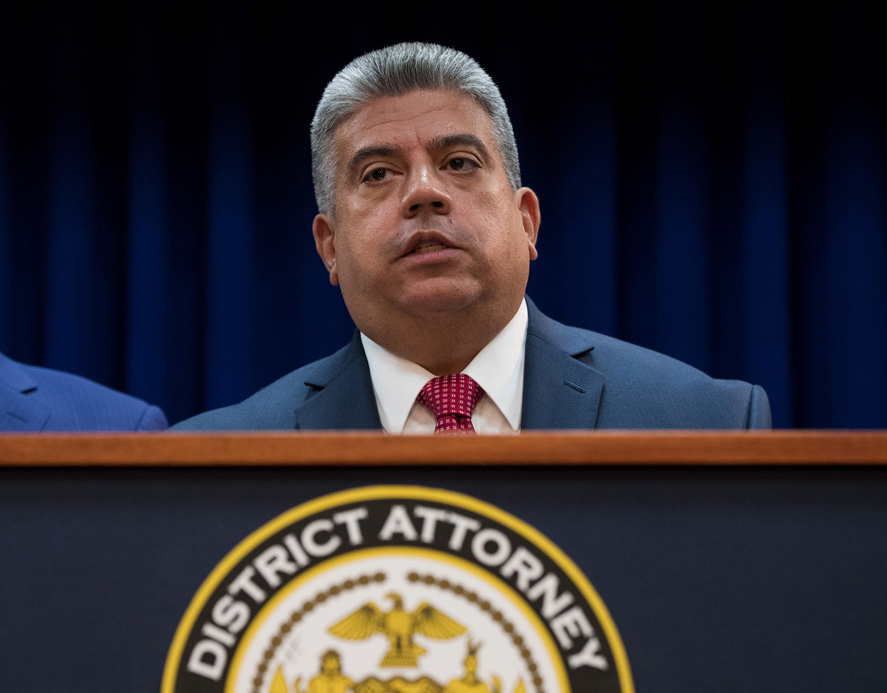

By Stephanie Don
BROOKLYN – After three bodies were found in a Brooklyn apartment in 1992, defendants Julian Yeats, 18, and Curtis Watson, 15—not their real names—were convicted of three homicides each.
However, after serving nearly 22 years in prison, Yeats and Watson were exonerated when District Attorney Eric Gonzalez assigned his Conviction Review Unit (CRU) to investigate the 1994 trials, and the unit found multiple issues in relation to the defendants’ confessions, police conduct, and prosecutor conduct—as well as new scientific evidence.
It was 28 years ago at around 6:45 a.m. that Yeats reportedly returned home and found the bodies of his mother, 12-year-old sister, and his sister’s 12-year-old friend stabbed in the chest with their wrists bound and electrical wire tired around their necks. The two girls were partially exposed but “neither had been the victim of sexual assault,” according to the medical examination.
Yeats notified his uncle, who called 911. Yeats then voluntarily returned to the police station with responding officers, accompanied by his friend Watson, where Yeats and Watson gave their separate police statements.
Yeats claimed he was with Watson from 8 p.m. on the night before the murders until 6 a.m. before discovering the bodies. Watson’s timeline of events agreed with Yeats’s. A mutual friend of the pair claimed he “dropped off the two defendants in a park some ways away from the Yeats apartment around 3 a.m.”
After the mutual friend gave his statement, detectives interrogated Yeats and Watson, both without the presence of a parent or guardian. During this second interrogation, Watson confessed to the murders. After being told of Watson’s confession, Yeats also confessed.
In Watson’s confession, he told detectives that “upon returning to the Yeats apartment, Yeats stabbed his mother, with Watson holding her. Yeats and Watson then removed the clothing of the girls,  who were asleep in another room, and fondled them. When the girls woke up, Yeats and Watson stabbed them.”
who were asleep in another room, and fondled them. When the girls woke up, Yeats and Watson stabbed them.”
Watson was the first to be tried and convicted of three counts of murder in the second degree. In Yeats’ trial, Watson testified against him, which resulted in a hung jury. In Yeats’ retrial, he was also convicted of three counts of murder in the second degree.
The CRU reported that suspecting an innocent person and subjecting them to interrogation could cause them to falsely confess—even when interrogation is done correctly. In the case of Yeats and Watson, “a mixture of pressure and a questioning technique that fed key facts of the crime to the suspects led to false or unreliable confessions.”
The CRU found that interrogated juveniles were more likely to falsely confess. Watson was entitled to have a parent or guardian present during his interrogation but did not. Without the presence of an adult, the CRU posed that Watson’s confession could have been coerced.
The content of Watson’s confession was also suspicious. The CRU described withholding case information from suspects as “textbook interrogation practice,” as the police did when interrogating Yeats and Watson. However, Watson’s confession did not fully match physical evidence.
Firstly, the confessions described removing the clothing from the two girls, despite both girls being found with their clothes on.
Second, Yeats and Watson described stabbing the victims, not strangling them. According to the CRU, “strangulation is a fact unlikely to be omitted by someone providing a truthful account.”
Third, the timeline in the confessions did not align with medical evidence, which suggested that the victims died before 6 a.m., the time of which Yeats and Watson confessed to killing the victims.
In addition to the contradictions between the confessions and medical evidence, the medical examiner may have demonstrated expectation bias during the trials and inadvertently caused a discrepancy in medical evidence.
The medical examiner testified that the time of the victims’ death was “possible at or around 6 or 7 a.m.,” which corroborated with the confessions. However, the medical evidence found that “the state of rigor observed in the bodies . . . indicated that the most probable time of death was more likely several hours earlier” than 6 or 7 a.m. The CRU found that the medical examiner may have placed the time of death around 6 or 7 a.m. because Yeats and Watson had already confessed, not according to medical evidence.
Despite these contractions, the police’s “tunnel vision” and focus on the confessions allowed them to close the case. The CRU found that the police did not look into multiple leads, including people around the Yeats apartment who abused street drugs.
The CRU placed responsibility with both the police and prosecutors, who should have more objectively reviewed “the believability . . . that this elaborate triple murder was in fact perpetrated by the 18-year-old son and brother of the victims and his 15-year-old friend.”
When Yeats filed to appeal his conviction, new DNA testing technology that was not available in 1994 was applied to DNA found on a victim’s clothing and under another victim’s fingernail.
While the DNA found on the victim’s clothing did match Yeats, the evidence was dismissed due to the fact that Yeats lived in the apartment with two of the victims. The DNA found under the other victim’s fingernail did not match Yeats or Watson but matched with DNA connected to an unsolved homicide from 1999, when Yeats and Watson had begun to serve time.
Ultimately, the CRU found that the DNA evidence alone was enough to exonerate both Yeats and Watson after they served nearly 22 years in person.
To sign up for our new newsletter – Everyday Injustice – https://tinyurl.com/yyultcf9
